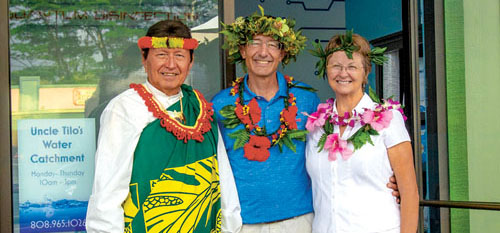Managing with Aloha: The Role of the Manager, Redesigned and Reconstructed
Series 3 on Managing with Aloha, Bringing Hawai‘i’s Universal Values to the Art of Business. Fifth in Series Three on Managing with Aloha
By Rosa Say
People ask me, “What’s a good jumpstart to help me deep dive into a Managing with Aloha practice?”
First, read the book for an overall picture of what the philosophy is all about, and read it with purpose: what are your goals? Freshly articulate them.
Second, identify your core values personally and professionally: understand which beliefs and convictions propel you forward, for they drive your life and your work when pursuing Ho‘ohana, the value of worthwhile work. Identifying your values is the first step to harnessing their energy; get them to help you feel the work you do is for you and on you as your ethos.

Third, start doing the Daily 5 Minutes immediately, the conversational practice described in chapter 11 of the book on ‘Ike loa, the value of learning. It will help you become a “good receiver,” practicing no-agenda listening as it keeps you connected to the practical relevancy of your everyday work and essential relationships. If you do not have direct reports, do it with your peers. I cannot overstate how useful this is: your Daily 5 Minutes helps you prioritize and “keep it real” with right task/right time focus, illuminating the action steps you need to take each day thereafter as it simultaneously strengthens your partnerships.
Finally, commit to Key Concept 4, The Role of the Manager Reconstructed, for that’s where the magic of true “with Aloha” management for the better happens. This is the key which opens the door to all 9 concepts. Let’s examine this part of the Managing with Aloha jumpstart more fully.
Can you guess who has the worst, most useless job position description (JPD) in every company universally, and no matter what the mission and vision of that company may be? Managers.
They often have no JPD at all, for managers are largely expected to write it for themselves—to show up where needed, and then be there as stopgap or emergency valve. They babysit—everyone cringes when I use that word, yet if they’re honest, they’ll admit that’s what they mostly do. They aspire to leadership by neglecting its foundation in good management.
Therefore, when we at Say Leadership Coaching take on a coaching project, we initiate the same jumpstart just recommended to you:
We identify that company’s mission and vision; we identify the core values we need to align all our recommendations and actions with; we teach and coach the Daily 5 Minutes to involve people immediately with difference-making participation; and we take steps to reimagine, redesign, reconstruct and then implement a renewed role for all managers in the company as quickly and as comprehensively as possible.
Are JPDs a traditional tool in your company? Keep using them IF you continually revise them to ensure they’re relevant and useful. JPDs should be personalized to the mission of your company and to a person’s Ho‘ohana when seen as their professional mission statement. Therefore, I can’t propose a draft for you. Yet I can give you the guideline we share. Use this in your Key 4 reconstruction as goal-setting: is this result what your JPD would achieve?
“Managers must own workplace engagement and be comfortable with facilitating change, creative innovation, and development of the human asset. The ‘reconstruction’ we require in Managing with Aloha is so this expectation of the Alaka‘i Manager is both reasonable and possible, and so they can channel human energies as a company’s most important resource, they themselves having the time, energy, and support needed in doing so. Convention may work against us, where historically, people have become managers for reasons other than the right one: Managing people is their calling. A new role for managers must be explicitly valued by the entire organization as critically important to their better success: Managers can then have personal bandwidth for assuming a newly reinvented role, one which delivers better results both personally and professionally, and in their stewardship of the workplace culture.”
Managers should be creative initiators, coaches and culture stewards. Realistically, they may become babysitters, stopgaps and emergency valves at times, but those become very rare and short-term conditions in reconstruction—even ‘temporary’ and ‘acting’ is unreasonable and unhealthy in workplace cultures managed with Aloha—correct course and/or fill your vacancies quickly.
The role of the manager has become crucial in our time, when Human Resources is no longer the manager’s stopgap, emergency valve, or resource, primarily focused as they are on laws, regulations, benefit costs, and negotiation.
I say, bring it on. I have the utmost faith in Alaka‘i Managers as those who can do ‘human resources’ better than it has ever been done before. ❖
The Role of the Manager Reconstructed is Key Concept 4 in the Managing with Aloha philosophy: we reimagine, redesign, and reconstruct the ROLE managers play in the optimal business model for your company. Next issue, we’ll talk about Key Concept 5: Language of Intention.
Contact writer Rosa Say at RosaSay.com or ManagingWithAloha.com


